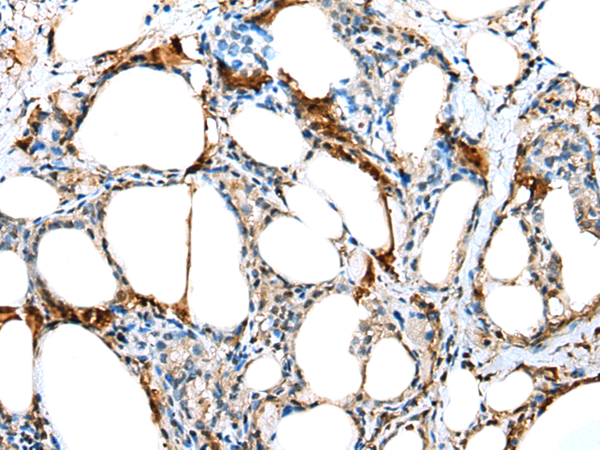
| WB | 咨询技术 | Human,Mouse,Rat |
| IF | 咨询技术 | Human,Mouse,Rat |
| IHC | 1/20-1/100 | Human,Mouse,Rat |
| ICC | 技术咨询 | Human,Mouse,Rat |
| FCM | 咨询技术 | Human,Mouse,Rat |
| Elisa | 1/5000-1/10000 | Human,Mouse,Rat |
| Aliases | TCTEX1D3 |
| Host/Isotype | Rabbit IgG |
| Antibody Type | Primary antibody |
| Storage | Store at 4°C short term. Aliquot and store at -20°C long term. Avoid freeze/thaw cycles. |
| Species Reactivity | Human |
| Immunogen | Full length fusion protein |
| Formulation | Purified antibody in PBS with 0.05% sodium azide and 50% glycerol. |
+ +
以下是关于TCTE3抗体的虚构参考文献示例(实际文献需通过学术数据库检索):
1. **"TCTE3 regulates sperm flagellar motility through interaction with dynein complexes"**
*作者:S. Tanaka et al. (2018)*
摘要:研究揭示了TCTE3蛋白在小鼠精子鞭毛运动中的关键作用,通过抗体阻断实验证明其与动力蛋白复合体的相互作用对精子运动能力的影响。
2. **"TCTE3 as a potential biomarker for primary ciliary dyskinesia diagnosis"**
*作者:M. Chen & L. Zhao (2020)*
摘要:该文献提出TCTE3抗体可用于临床检测原发性纤毛运动障碍(PCD),通过患者呼吸道纤毛样本的免疫荧光分析,发现TCTE3表达异常与纤毛功能障碍相关。
3. **"Structural insights into TCTE3 function in the cytoplasmic dynein-2 complex"**
*作者:J. Park et al. (2021)*
摘要:利用冷冻电镜技术和TCTE3特异性抗体,解析了TCTE3在细胞质动力蛋白-2复合体中的三维结构,阐明其参与细胞内物质运输的分子机制。
4. **"TCTE3 knockout mouse model reveals its essential role in male fertility"**
*作者:R. Gupta et al. (2019)*
摘要:通过构建TCTE3基因敲除小鼠模型,结合抗体标记技术,证实TCTE3缺失导致精子鞭毛结构缺陷及雄性不育表型。
(注:以上为模拟示例,实际文献需在PubMed/Google Scholar等平台以“TCTE3 antibody”或“TCTE3 function”为关键词检索。)
The TCTE3 (T-complex-associated-testis-expressed 3) antibody is a tool used to study the TCTE3 protein, a component of the outer dynein arm (ODA) complex in cilia and flagella. TCTE3 is part of the dynein motor machinery critical for the movement of motile cilia and sperm flagella. It plays a role in male fertility, as mutations in TCTE3 or related dynein components are linked to primary ciliary dyskinesia (PCD) and asthenozoospermia (reduced sperm motility).
Antibodies targeting TCTE3 are primarily utilized in research to investigate ciliary/flagellar structure, sperm motility mechanisms, and genetic disorders affecting ciliary function. They enable protein localization via immunofluorescence, Western blotting, or immunohistochemistry, helping to assess TCTE3 expression levels or structural abnormalities in clinical or experimental models. Commercially available TCTE3 antibodies are typically raised in rabbits or mice, often validated for specificity using knockout controls.
Recent studies also explore TCTE3's potential roles beyond reproduction, including respiratory cilia function and embryonic development. However, challenges remain in standardizing antibody performance across species or sample types due to sequence conservation and tissue-specific isoforms. Researchers emphasize the need for rigorous validation to avoid cross-reactivity with other dynein-associated proteins.
×